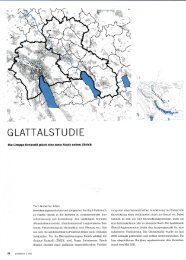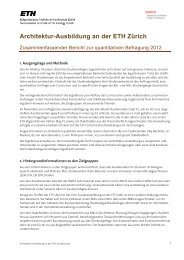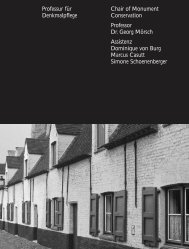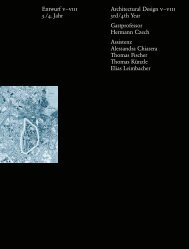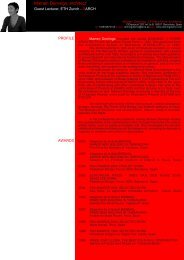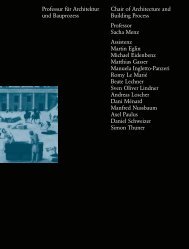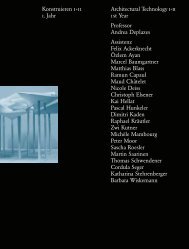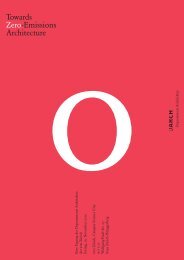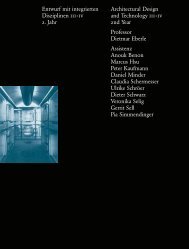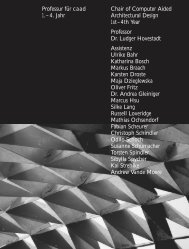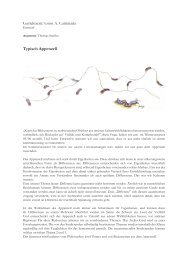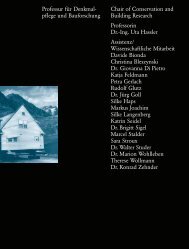Jahrbuch PDF (63MB) - ETH Zurich - ETH Zürich
Jahrbuch PDF (63MB) - ETH Zurich - ETH Zürich
Jahrbuch PDF (63MB) - ETH Zurich - ETH Zürich
Sie wollen auch ein ePaper? Erhöhen Sie die Reichweite Ihrer Titel.
YUMPU macht aus Druck-PDFs automatisch weboptimierte ePaper, die Google liebt.
Vittorio Magnago Lampugnani<br />
NSL/Institut ISB Departement Architektur<br />
Tina Pujara<br />
Typus «Square» – ein von Häuserreihen gefasster und<br />
meist mit Grünräumen im Zentrum besetzter öffentlicher<br />
Raum – geprägt.<br />
Die Arbeit befasst sich mit den Hintergründen und<br />
Einflüssen, welche die Transformationen dreier ursprünglich<br />
ländlicher Estates – Grosvenor, Portland und<br />
Portman – in ein urbanes Stadtviertel lenkten. Sie erforscht<br />
unter anderem, weshalb – trotz der über zweihundert<br />
Jahre dauernden, teilweise durch politische und ökonomische<br />
Krisen beeinflussten Entwicklung der drei<br />
untersuchten Estates – schlussendlich ein strukturell<br />
homogener Stadtteil entstanden ist.<br />
Strategien zum Wiederaufbau in der Nachkriegszeit:<br />
Golden Lane und Barbican Estates in London<br />
Vor dem Zweiten Weltkrieg war das gesamte Stadtgebiet<br />
um den Golden Lane und den Barbican Estate dicht be-<br />
Transformation der Freiraumstruktur<br />
in Londons West End im<br />
18. und 19. Jahrhundert<br />
baut. In kleinen Fabriken und Ateliers wurde vorwiegend<br />
Produkte für den Juwelen- und Textilhandel produziert.<br />
Mit Ausnahme weniger Gebäude wurde die Bebauungsstruktur<br />
durch Luftangriffe komplett zerstört; hingegen<br />
blieben die Strassen und Bahnlinien weitgehend intakt.<br />
Nach dem Krieg war die Wohnungsnot innerhalb<br />
Londons gross. Deshalb entschied die Stadtverwaltung,<br />
den Golden Lane und den Barbican Estate nicht als<br />
durchmischte Geschäfts- und Industrieviertel, sondern als<br />
Wohngebiet wieder aufzubauen. Zu diesem Zweck<br />
wurde 1951 in Zusammenarbeit mit dem riba ein öffentlicher<br />
Wettbewerb für einen Gestaltungsplan des Golden<br />
228<br />
(estates) were themselves mainly responsible for building<br />
in areas outside the medieval city center. Due to liberal<br />
building regulations, they were able to act on their own<br />
personal wishes and preferences. It is thanks to these<br />
circumstances that the morphology of the city of London<br />
was decisively shaped by the ‘square’ as an architectural<br />
type – a public space surrounded by rows of houses and<br />
usually with green areas in its center.<br />
The study is concerned with the background and influences<br />
affecting the transformations of what were<br />
originally three rural estates – Grovsenor, Portland and<br />
Portman – into urban districts of the city. It investigates,<br />
among other things, how it was possible for a structurally<br />
homogeneous district to arise out of the three<br />
estates examined, despite more than two centuries of development<br />
partly influenced by political and economic<br />
crises.<br />
von links nach rechts:<br />
1720, 1746, 1834<br />
Thomas Bowles, A View of<br />
Grosvenor Square, London, 1751,<br />
aus: Todd Longstaffe-Gowan,<br />
The London Town Garden<br />
1740–1840, New Haven &<br />
London, 2001<br />
Reconstruction Strategies in the Postwar Period:<br />
Golden Lane and Barbican Estates in London<br />
Before the Second World War, the whole municipal area<br />
around the Golden Lane and Barbican Estates was<br />
densely built up. There were small factories and workshops,<br />
mainly manufacturing products for the jewelry<br />
and textile trades. With only a few exceptions, the<br />
buildings were completely destroyed in the air raids;<br />
however, the streets and railway lines remained<br />
largely intact.<br />
After the War, there was a severe housing shortage in<br />
London. The city’s administration therefore decided not<br />
to rebuild Golden Lane and the Barbican Estate as a mixed<br />
business and industrial district, but instead as a residential<br />
area. A public competition was therefore held in 1951, in



